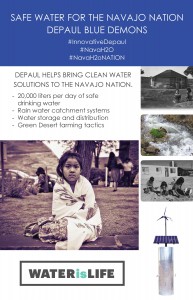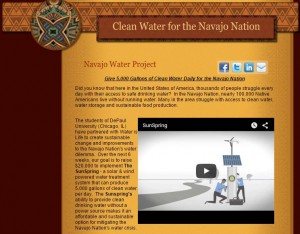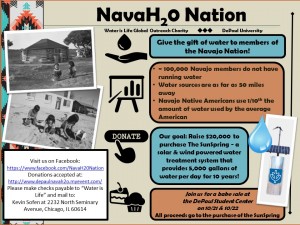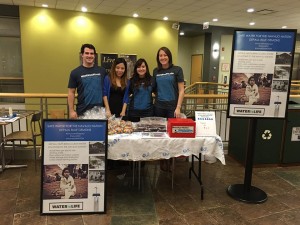Clean Water for the Navajo Nation

Project Description
On our first day of class, we learned that we had eight weeks to select a team, then a charity, organize a fundraising event, obtain donations, create a social network presence, and submit a final report and presentation. When we learned about our project assignment, we all agreed that we wanted to support a cause within the United States and a cause that would get everyone’s attention. Our group was lucky to have an individual who had both a personal and professional relationship with water charities. Through this connection and a CBS news story, we discovered the Navajo Nation.
Charity Description
Within the Navajo Nation, there are nearly 100,000 individuals without access to running water. Not to mention that these individuals also have unreliable electricity and unemployment is rampant. The CBS news story featured a woman called the “water lady” who drove miles away each day to obtain water for her fellow Navajo Nation residents. Unfortunately, so many individuals rely on her, she is only able to deliver to each family approximately once a month. We all reflected on how this would affect our daily lives, we were shocked this was happening in the United States. With this realization, we understood we had found our cause: it was local and it was definitely jaw dropping.
With the help of Kevin’s water connections, we formed a partnership with Water Is Life. Water Is Life is a charitable organization that has implemented water and hygiene projects internationally, Water Is Life has been active in Haiti and many African nations; and they were looking for a way to help the Navajo Nation. At this point, we evaluated the possible support options for the Navajo Nation. We set a lofty goal of raising $20k in order to purchase an item called a SunSpring. The SunSpring is a solar and wind powered water filtration system. Our plan was to work with Water Is Life to place the SunSpring near the Animas River to provide clean water for a nearby school. However, we knew that $20k was ambitious, so we developed less expensive alternatives, including permaculture and hygiene initiatives, which would cost approximately $5-6k.
As a group, we decided our primary means of fundraising would be by utilizing our own personal and professional networks, as well as through social media. We reached out to our friend, families, and colleagues via email. The email was standardized across our group, with a personal touch at the introduction. Also, as it turns out, our team included a social network genius and our Facebook page took off, beyond our wildest hopes (see us here: https://www.facebook.com/NavaH20Nation). Our main fundraising took place through our MyEvent page: http://www.depaulnavah2o.myevent.com/3/donate.htm.
As for our event, our goal was to make the most profit with as little overhead as possible. As a result, we ruled out places such as restaurants that would offer donations such as 15% of what our event spent at their facility. Our event went through many brainstorming phases, but we settled on a two day bake sale at the DePaul Lincoln Park Student Center. We all contributed our own baked goods and flyers and posters were created. During this event, we were able to not only raise funds, but also awareness.
Project Outcomes
Throughout this quarter, we have all become passionate about this cause and have vowed to keep our fundraising and awareness campaigns going. We have been blown away by the support we’ve received on Facebook, as well as the interest we received from our networks and the undergraduate students at DePaul. At this time we have raised nearly $3k on our MyEvent page and have secured the following additional donations: $2.5k match donation from a local bank, plus another $2.5k and an additional $5k match from one our team member’s employers, and another $3k donation from another one of our employers. This adds up to an astounding $16k!!
Lessons Learned
- Scope creep: We believe that our team avoided scope creep successfully. We had co-project managers who did an excellent job of keeping our team focused and on schedule. Without the guidance of these two, we could have easily ventured off our project plan.
- Communication: We utilized email and text message to share ideas and updates. Our project managers hosted a weekly phone call in which we reviewed our current progress and addressed the next steps. Our calls were well organized and kept to the designated appointment times.
- Shared responsibility: Each team member had components of the project that they were responsible for, some of which were shared. We trusted each other to be responsible and accountable. In the end, all team members met their objectives and communicated the progress clearly to the team.
- Organization: Our team, led by our project managers, was incredibly organized. We had a set timeline and plan, which we all understood. This shared understanding, which was rooted in our clear communication, was key to our success.
Advice
If you can, pick classmates you’re comfortable with and have compatible schedules with. Due to the short duration of the quarter, it will be important that you are able to communicate frequently and have times that you can meet with all team members. For our group, that meant that most of us were in the weekend program, because weekend days worked best for us.
Select a cause that everyone can support. If you select your charity well, you will see everyone’s dedication grow throughout the quarter. Your passion will also be conveyed during your donation request and awareness events, which makes a big difference in the support you receive.
For our team, the weekly phone calls were a great opportunity to summarize the emails and texts that had occurred, as well to finalize that week’s activities. While it may have been challenging for everyone to make it onto every call, we all made the effort and appreciated the outcomes of the weekly meeting. The summary emails that were sent out following the calls also played a large part in keeping everyone on task
Lastly, try to be prepared for the unexpected. None of us would have expected that bringing clean water to the Navajo Nation would be a controversial topic, but it turned out to be (see our Facebook page). In our case, the positive responses vastly outweighed the negative, but that may not always be the case.



